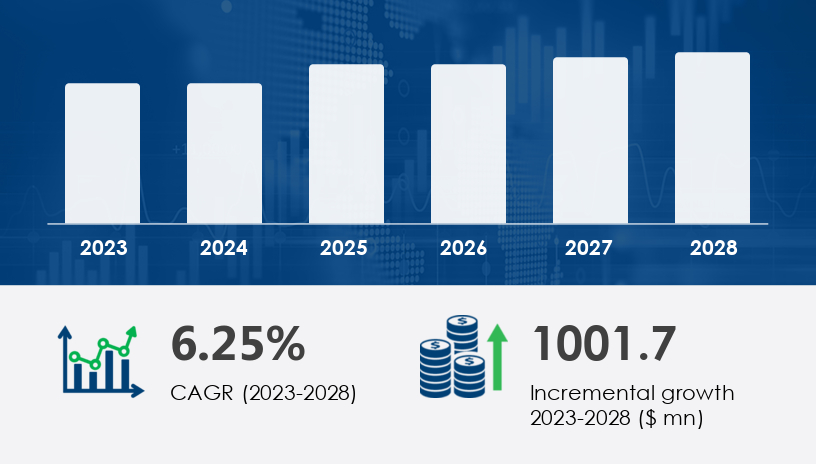The intrapartum monitoring devices market is poised for significant growth, with projections indicating an increase of USD 1 billion at a CAGR of 6.25% between 2023 and 2028. This growth is driven by advancements in technology, rising maternal health concerns, and increasing demand for continuous monitoring during labor. Intrapartum monitoring devices are essential tools used during labor to assess the well-being of both the mother and fetus. These medical devices provide real-time data on uterine contractions, fetal heart rate, and intrauterine pressure, enabling timely interventions and reducing the risk of complications.
For more details about the industry, get the PDF sample report for free

The Intrapartum Monitoring Devices Market is witnessing growing demand due to the increasing focus on maternal care and fetal health during labor. Devices for intrapartum monitoring are essential in assessing critical parameters such as fetal heart rate, maternal heart rate, and uterine contractions to ensure patient safety and positive health outcomes. Technologies such as fetal scalp electrode, intrauterine catheter, pressure transducer, and heart rate transducer are widely used in hospital monitors, maternity centers, and obstetric units for continuous observation. Modern solutions like non-invasive monitors, Doppler ultrasound, electronic fetal monitor, and fetal ECG provide accurate data for early detection of complications. Wireless patch technology and portable devices enable flexibility in various settings, including ambulatory surgery centers. These systems play a vital role in identifying early signs of fetal distress, thereby reducing risks associated with preterm birth, gestational diabetes, and high-risk pregnancy scenarios.
Preterm birth, defined as delivery before 37 weeks of gestation, is a significant health concern with potential consequences for both infants and mothers. Factors contributing to preterm birth include short interpregnancy intervals, in-vitro fertilization, infections, multiple pregnancies, and chronic conditions such as diabetes and hypertension. The increasing prevalence of preterm births is driving the demand for intrapartum monitoring devices to ensure optimal maternal and fetal health outcomes.
Advancements in technology have led to the development of non-invasive monitoring techniques and portable devices, making continuous monitoring more accessible and user-friendly. Integration with digital health platforms and telemedicine solutions enables remote monitoring and real-time data analysis, enhancing maternal-fetal care and clinical decision-making during childbirth.
Growing awareness and education about fetal and maternal care during labor have contributed to the increasing popularity of intrapartum monitoring devices. Health campaigns and government initiatives promoting safe childbirth practices are encouraging healthcare facilities to adopt advanced monitoring solutions.
See What’s Inside: Access a Free Sample of Our In-Depth Market Research Report.
Electrodes: Fetal scalp electrodes (FSEs) are used to monitor fetal heart rate directly from the fetal scalp. These devices provide more accurate readings compared to external transducers and are essential in detecting potential issues during vaginal deliveries and cesarean sections.
Monitors: Advanced fetal monitoring systems offer real-time data on fetal heart rate, uterine contractions, and intrauterine pressure, enabling timely interventions and reducing the risk of complications.
Hospitals: The hospital segment dominated the market in 2023 due to the high demand for advanced monitoring technologies and comprehensive maternal care services offered in these healthcare institutions.
Maternity Clinics/Obstetrics Clinics: This segment is projected to grow at a CAGR of 7.5% over the forecast period, driven by the increasing demand for specialized maternal care and personalized delivery experiences.
North America: North America is estimated to contribute 45% to the growth of the global market during the forecast period, driven by advancements in technology and the availability of various solutions from market companies.
Europe: European countries' emphasis on improving healthcare standards and investments in advanced medical technologies are contributing to the growth of the intrapartum monitoring devices market in this region.
Asia: The Asia Pacific intrapartum monitoring devices market is anticipated to witness significant growth due to the availability of better healthcare facilities and increasing consciousness among the population concerning maternal and fetal tracking.
Recent research in the Intrapartum Monitoring Devices Market highlights the growing use of AI technology, machine learning, and data analytics to enhance diagnostic precision and predict complications like birth asphyxia, neonatal seizures, brain damage, and cerebral palsy. Advanced fetal monitoring systems now offer real-time data on maternal vital signs and contraction patterns, improving responsiveness in emergency situations. The integration of telemedicine and remote monitoring capabilities through mHealth solutions allows clinicians to track patients outside of traditional settings. These systems often leverage voltage-based technology and radiofrequency signals to improve accuracy and signal clarity. Enhanced connectivity and telemedicine integration are transforming maternal-fetal care, particularly in underserved regions. With a focus on improving neonatal care and streamlining communication between care teams, intrapartum monitoring technologies continue to evolve as critical tools in modern perinatal healthcare infrastructure.
Innovation and Product Development: Companies should focus on developing non-invasive, wireless, and portable intrapartum monitoring devices to enhance patient comfort and accessibility.
Market Expansion: Expanding into emerging markets with increasing healthcare infrastructure can provide growth opportunities for market participants.
Regulatory Compliance: Ensuring compliance with stringent regulatory requirements is crucial for the safety and accuracy of intrapartum monitoring devices.
The intrapartum monitoring devices market is expected to continue its growth trajectory, driven by technological advancements, increasing maternal health concerns, and rising demand for continuous monitoring during labor. The development of non-invasive, wireless, and portable devices will further enhance patient comfort and accessibility, making continuous monitoring more feasible in various healthcare settings.
Get more details by ordering the complete report
Regulatory Hurdles: Navigating the complex regulatory landscape can delay product development and market entry.
Cost Constraints: High costs associated with advanced monitoring devices may limit their adoption in low-resource settings.
Data Security: Ensuring the security and privacy of patient data is paramount, especially with the integration of digital health platforms.
Invest in R&D: Allocate resources to research and development to create innovative and cost-effective intrapartum monitoring devices.
Collaborate with Healthcare Providers: Partner with hospitals and maternity clinics to understand their needs and tailor products accordingly.
Enhance Training and Support: Provide comprehensive training and support to healthcare professionals to ensure the effective use of monitoring devices.
Safe and Secure SSL Encrypted